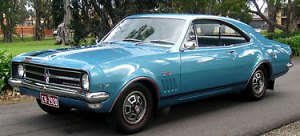
| - |
Production plants: Elizabeth (cars), Port Melbourne (engines)

2017: 90,306 units (23,676 units Commodore) (Last year of production)
2016: 94,308 units (25,860 units Commodore)
2015: 102,951 units (27,770 units Commodore)
2014: 106,092 units (30,203 units Commodore)
2013: 112,059 units (27,766 units Commodore)
2012: 114,665 units (30,532 units Commodore)
2011: 126,095 units (40,617 units Commodore)
2010: 132,923 units (45,956 units Commodore)
2009: 119,568 units (44,387 units Commodore)
2008: 130,338 units (51,093 units Commodore)
2007: 146,680 units (57,307 units Commodore)
2006: 146,511 units (56,531 units Commodore)
2005: 174,464 units (66,794 units Commodore)
2004: 178,027 units(79,170 units Commodore)
* Apart from the locally produced Commodore family, a large number of sales was contributed by vehicles supplied by GM Korea and Opel.
However, as Australia gradually lifted import tariffs on cars since the 2000s, its motor industry was exposed to stiff foreign competition. GM found Holden as well as the entire Australian motor industry was burdened by high production costs, thus it eventually ended the local production in 2017. Since then Holden became only a local sales branch selling rebadged cars produced elsewhere. As a result, this page will not be updated anymore.
Strictly speaking, Australia did not have a real motor industry until the end of WWII, when the government promoted to build the first Australian car. Holden's first locally built car was born in 1948. It was derived from an abandoned GM design and underwent development in Detroit. In the next 30 years, Holden gradually increased the Australian content of its cars, although most technology still came from Detroit. Holden offered only one line of cars - initially Special, then Kingswood, but it easily dominated the isolated Australian market together with local rival Ford Falcon, thanks to high tariffs imposed on imports. It also introduced high-performance V8 models to delight car lovers.
 1968 Monaro coupe
1968 Monaro coupeFrom the late 1970s, Holden abandoned American design and based its new Commodore on Opel Rekord, then Omega, though they continued to use American engines. In 1988, it collaborated with Tom Walkinshaw to establish HSV (Holden Special Vehicle), which modified Commodores into high-performance machines.
Following Opel's withdrawal from large car market in the mid-1990s, Holden started upgrading its R&D capability. The 1997 Commodore VT still looked like the late Opel Omega, but it was heavily redesigned to be bigger, tougher and cheaper to build. Its success convinced GM to assign Holden as the sole development center for its new global RWD large car platform, Zeta. After all, at the time Australia was probably the largest market for affordable RWD cars.
 1997 Commodore VT
1997 Commodore VT2004 saw the first truly Holden-designed engine, Alloytec V6. It was so good that Detroit decided to employ it in its own cars ! The 2006 Commodore VE (based on Zeta platform) was finally the first Holden designed by itself from draft. Unfortunately, by then the large car market in Australia was shrinking, blame to high fuel price and environmental concern. Both Commodore and its arch-rival Ford Falcon suffered. Besides, Toyota Camry and Aurion consistently ate into the market share of them.
Sales of Commodore kept sliding in the 2010s. As Australia lifted import tariffs under international trade agreements, its motor industry was subjected to stiff foreign competition, and their high production costs became harder and harder to bear. GM eventually shut down the Elizabeth factory on the 20th October, 2017, ending the local production that started 69 years ago. A total of 7,687,675 Holden vehicles had been built in Australia. As Ford and Toyota already ended local production earlier, Australian motor industry was effectively dead.